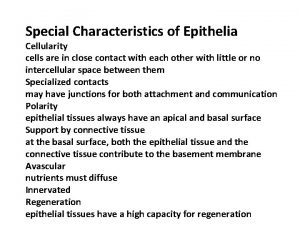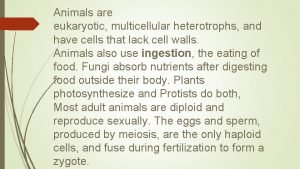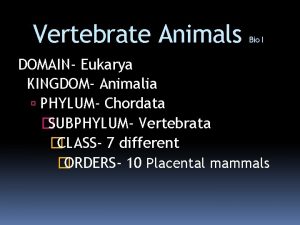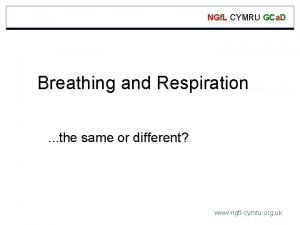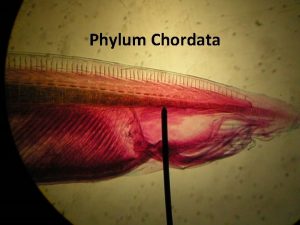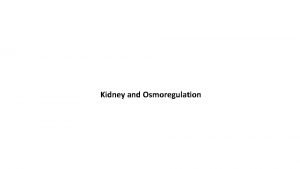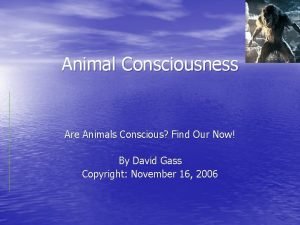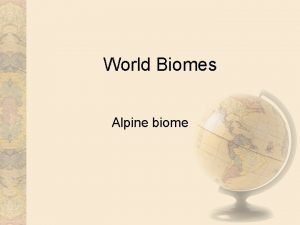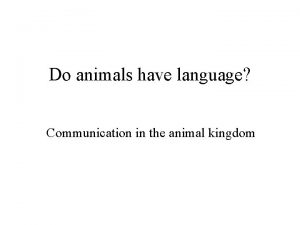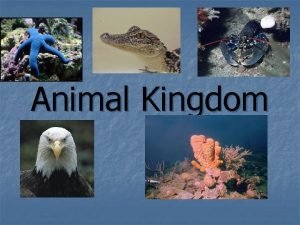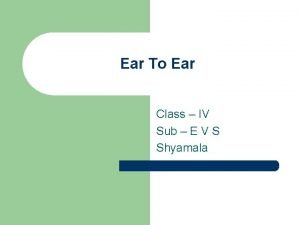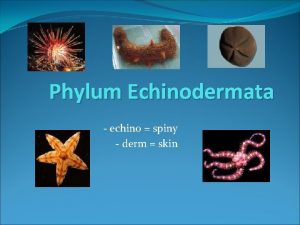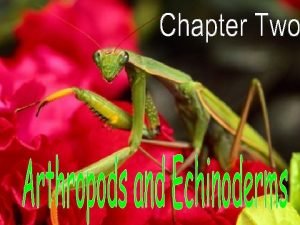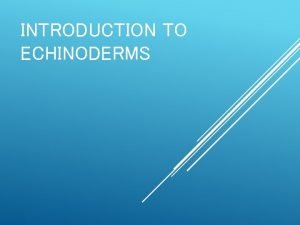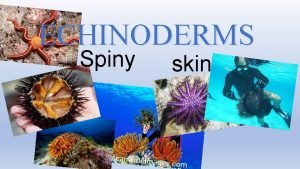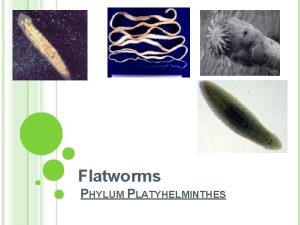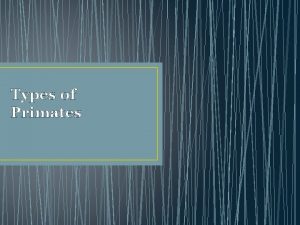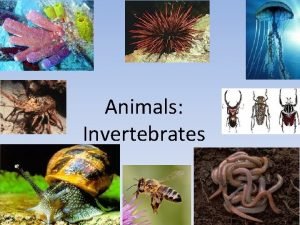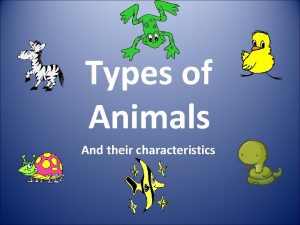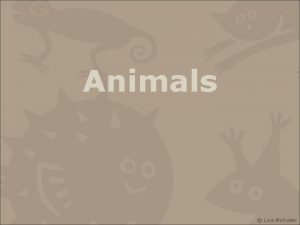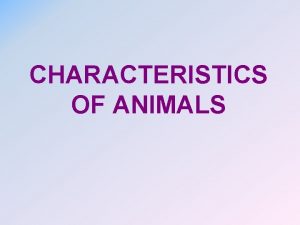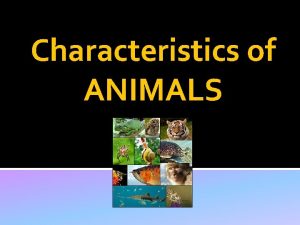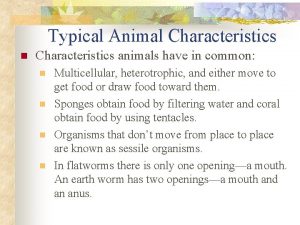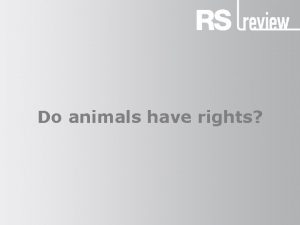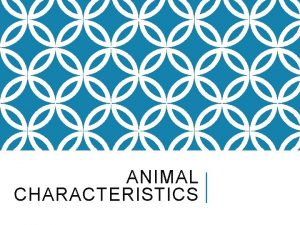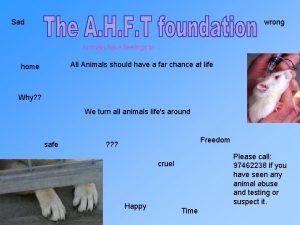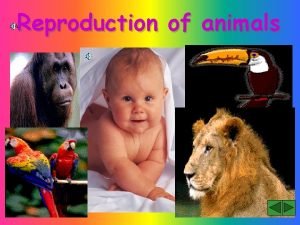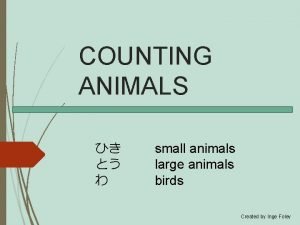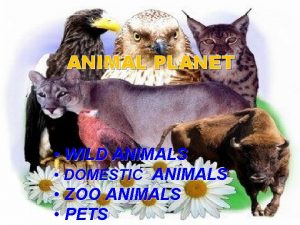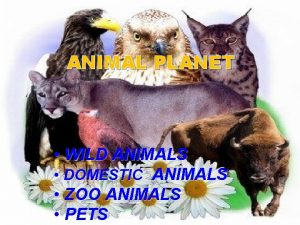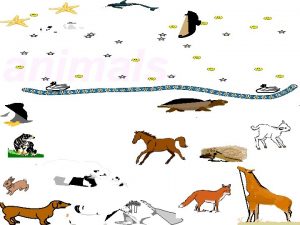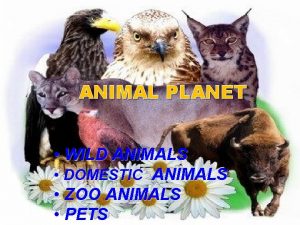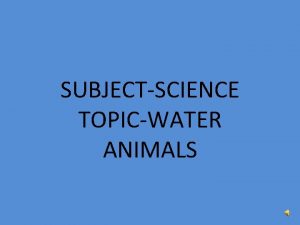All animals have this characteristics HETEROTROPHY MULTI CELLULARITY




































- Slides: 36


All animals have this characteristics: - HETEROTROPHY - MULTI CELLULARITY - ACTIVE MOVEMENT - DIVERSITY in FORM and in HABITAT - SEXUAL REPRODUCTION - EMBRYONIC DEVELOPMENT

Heterotrophy: they obtain energy and organic molecules by ingesting other organism Multicellularity: all animals are multicellular; many have complex bodies like that of this jellyfish (phylum Cnidaria).

Tissues: the cells of all animals (except sponges) are organized into structural and functional units called tissues. Animals are unique in having two tissues associated with movement: muscle tissue and nervous tissue. Active Movement: animals move more rapidly and in more complex ways than members of other kingdoms.

Diversity in Form: animals vary greatly in form, ranging in size from organisms too small to see with the unaided eye to enormous whales and giant squids. Diversity in Habitat: members of fewer phyla occur in fresh water, and members of fewer still occur on land.

Sexual Reproduction. Most animals reproduce sexually: the reproduction take place between a male and a female and by the union of both the gametes. Embryonic Development. An animal zygote first have a series of mitotic divisions, called cleavage, that produces: - the blastula - after, the blast pore. (An embryo at this stage is called a gastrula) - finally it develop in a ‘larva’, the primitive form of the living being.


Vertebrates: general features • The vertebrates- chordate- are animals that have a internal structure: the spinal cord or vertebral column

Vertebrates: general features • Vertebral column The defining characteristic of a vertebrate is the vertebral column: in all chordates has been replaced by a segmented series of vertebrae separated by intervertebral discs.

Vertebrates: general features Central nervous system The central nervous system of vertebrates is based on a hollow nerve cord running along the length of the animal. The presence of neural crest cells is of particular importance and unique to vertebrates. The vertebrates are the only chordate group to exhibit cephalization. Animals have a center of control of the whole nervous system in the head

Vertebrates: general features All basal vertebrates breathe with gills. Each gill is supported by a cartilagenous or bony gill arch. The bony fish have three pairs of arches, cartilaginous fish have five to seven pairs, while the primitive jawless fish have seven. The vertebrate ancestor are divided in amphibians and some primitive bony fishes. These are reduced in adulthood, their function taken over by the gills proper in fishes and by lungs in most amphibians. The complex internal gill system as seen in fish apparently being irrevocably lost very early in the evolution oftetrapods. While the higher vertebrates do not have gills, the gill arches form during fetal development.


Subphylum Vertebrata Conventional classification has living vertebrates grouped into seven classes: • • Class Agnatha (jawless fishes) Class Chondrichthyes (cartilaginous fishes) Class Osteichthyes (bony fishes) Class Amphibia (amphibians) Class Reptilia (reptiles) Class Aves(birds) Class Mammalia (mammals)

Jawless fish • The first living vertebrates belong to class of jawless fish. They have this characteristics: they have a mouth without jaw. Many examples are: the lamprey and hagfish.

FISH • CARTILAGINOUS FISH: some fishes (called condrittes ) have skeleton been of cartilaginous: are the sharks and the wonderful skate, that have gills made from big crakes. Cartilaginous fish breathe oxygen solving in water. • BONY FISH: the bony fish have three pairs of arches. Skeleton is made of clothes simile to then the our bony and the gills that are protect by operculum.

AMPHIBIANS • The amphibians live a part of their life on the water and a part on the earth. • They breathe with a rudimental lung. Their lungs aren’t efficient.

Reptiles were the first vertebrate able to do all of their cycle of life outside water. Dinosaurs were reptiles. Reptiles breathe through lungs and they are animal to cold blood, such as fishes and amphibians. Their body is cover to scales. The biggest group of reptiles is that of sauros.

BIRDS • After fish, “birds” is the most numerous of the vertebrates group. They descends directly from dinosaurs. They lay eggs for the reproductions.

MAMMALS Their peculiarity are: they have coat and mammals glands ( only the female). They are divided into: placental marsupials and monotrems.




EVOLUTION OF THE ANIMAL BODY PLANE Three key innovations can be noted in animal evolution: • 1. The evolution of symmetry • 2. The evolution of tissues, allowing specialized structures and functions • 3. The evolution of a body cavity

EVOLUTION OF SIMMETRY 1. The body of a member of phylum Cnidarians exhibits radial symmetry. It means that any longitudinal plane passing through the central axis.

The bodies of most animals other than sponges and cnidarians exhibit bilateral symmetry , in which the body has right and left halves that are mirror images of each other. Animals with this body plan are collectively termed the Bilateria.

THE IMPORTANCE OF INTERNAL CAVIETES A key innovation in the body plan of some bilaterians was a body cavity isolated from the exterior of the animal. This is different from the digestive cavity. The evolution of efficient organ systems within the animal body was not possible until a body cavity evolved. The cavity is filled with fluid: in most animals, the fluid is liquid.

The animals that not have body cavity are called acoelomate animals. So the space between tissues that develop from the mesoderm and the endoderm is filled with cells and connective tissue.

Coelomates have a body cavity, the coelom, that develops entirely within tissues derived from the mesoderm, and so is lined on both sides by tissue derived from the mesoderm.

A body cavity called the pseudocoelom develops embryologically between mesoderm and endoderm, so occurs in the adult between tissues derived from the mesoderm and those derived from endoderm; animals with this type of body cavity are termed pseudocoelomates.

EVOLUTION OF TISSUES The zygote (a fertilized egg), has the capability to give rise to all the kinds of cells in an animal’s body. That is, it is totipotent (all powerful). During embryonic development, cells specialize to carry out particular functions. In all animals the process is irreversible: once a cell differentiates to serve a function, it and his descendans can never serve any other.

Evolutionary history • Vertebrates originate during the Cambrian explosion. The earliest known vertebrate is believed to be the Myllokunmingia. Cambrians had the basic vertebrate body plan: a notochord, rudimentary vertebrae, and a well-defined hed and tail.

• From fish to amphibians • The first jawed vertebrates appeared in the latest Ordovician and became common in the "Age of Fishes". The two groups of bony fishes, evolved and became common. The Devonian also saw the rise of the first labyrinthodonts, which was a transitional form between fishes and amphibians.

• Mesozoic vertebrates • The Amniotes branched from labyrinthodonts and the diapsids became dominant during the Mesozoic. In the sea, the bony fishes became dominant. The birds a derived form of dinosaurs evolved in the Jurassic. Mammals had evolved from therapsids, during the late Triassic Period.

After the Mesozoic During the Cenozoic world has seen great diversification of bony fishes, frogs, birds and mammals. In this period over half of all living vertebrate species are fishes. Fishes are the main predators in most of the world’s water bodies. The rest of the vertebrate species are amphibians, mammals, reptiles and birds. Tetrapods comprise the dominant mega fauna of most terrestrial environments and also include many partially or fully aquatic groups.

Thank you for the attention By Michele Borsani Michela Mussi Raffaele Negri Michele Vignati

subus
 Cellularity of epithelial tissue
Cellularity of epithelial tissue Waiting line management
Waiting line management Multi loop pid controller regolatore pid multi loop
Multi loop pid controller regolatore pid multi loop Name 3 points
Name 3 points Https://a-z-animals.com/animals/
Https://a-z-animals.com/animals/ Consumers producers and decomposers
Consumers producers and decomposers G h patel college of engineering and technology
G h patel college of engineering and technology Carnivore
Carnivore It has 6 faces 12 edges and 8 vertices
It has 6 faces 12 edges and 8 vertices Multicellular heterotrophs
Multicellular heterotrophs Symbolize the statement “all cats are animals”.
Symbolize the statement “all cats are animals”. All vertebrate animals are in domain
All vertebrate animals are in domain Wserals
Wserals Once upon a time there lived a duck and a kangaroo
Once upon a time there lived a duck and a kangaroo All animals are equal
All animals are equal Ngfl all about animals
Ngfl all about animals Chapter 15 ocean water and ocean life
Chapter 15 ocean water and ocean life 5 types of symbiosis
5 types of symbiosis Notochord
Notochord Why do desert animals have longer loop of henle
Why do desert animals have longer loop of henle 4 types of eukaryotic cells
4 types of eukaryotic cells Metanephridia
Metanephridia Do animals have consciousness
Do animals have consciousness Every living plants and animals must have
Every living plants and animals must have Vicuña biome
Vicuña biome Do animals have language
Do animals have language The kingdom of animals
The kingdom of animals Animals whose ears we cannot see
Animals whose ears we cannot see Spiny skin echinoderms
Spiny skin echinoderms Invertebrates without legs
Invertebrates without legs Spiny skinned animals have an endoskeleton formed with
Spiny skinned animals have an endoskeleton formed with Spiny skinned animals have an endoskeleton formed with
Spiny skinned animals have an endoskeleton formed with Phylum annelida consists of unsegmented worms.
Phylum annelida consists of unsegmented worms. Types of anthropoids
Types of anthropoids Vertebrates and invertebrates classification
Vertebrates and invertebrates classification Characteristics of invertebrates animals
Characteristics of invertebrates animals Mammals
Mammals
